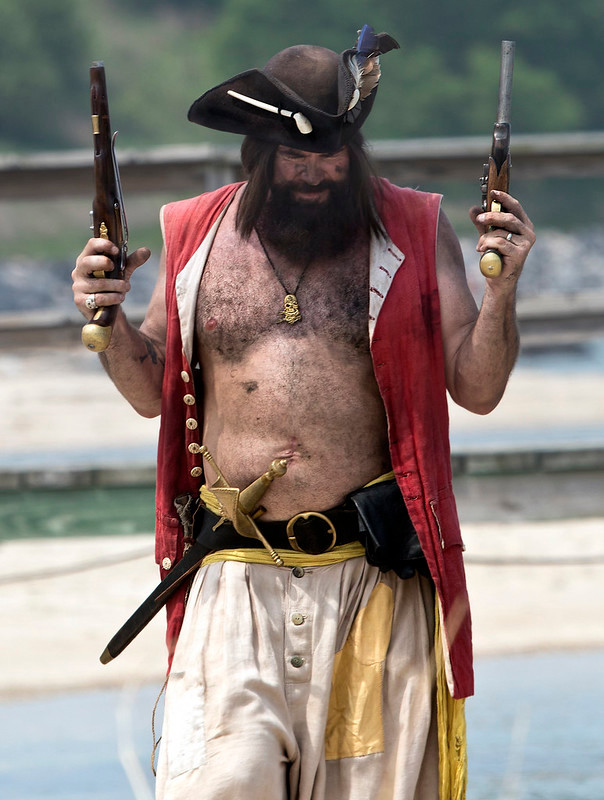
dressing up as a pirate has become a form of modern entertainment
Source: C Watts, Yorktown Pirate Festival - Virginia

dressing up as a pirate has become a form of modern entertainment
Source: C Watts, Yorktown Pirate Festival - Virginia
Stories about buried treasure in Virginia still stimulate people to dig holes and try to decipher maps and codes.
The Virginia Beach Convention and Visitors Bureau suggests that Edward Teach, the pirate known as Blackbeard, looted merchant a ship in the Chesapeake Bay near the Lynnhaven River. However, the pirates had to hide the treasure in what is today First Landing State Park.
According to the Convention and Visitors Bureau, once upon a time long long ago:1
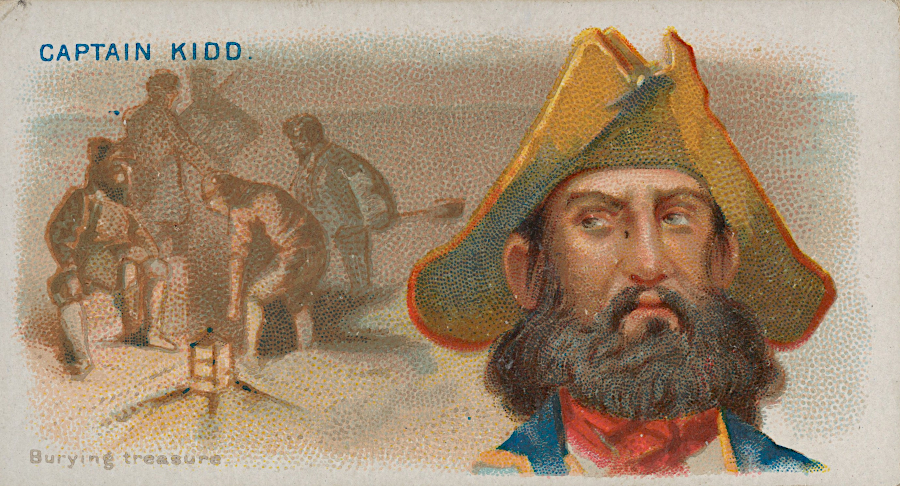
if pirates buried treasure on Virginia beaches... it is still waiting to be found
Source: Metropolitan Museum of Art, Captain Kidd, Burying Treasure (from the Pirates of the Spanish Main series (N19) for Allen & Ginter Cigarettes)
Holes have been dug in an island within Lake Joyce, which was once the Lynnhaven River outlet, based on rumors that Blackbeard buried his treasure there. As noted by a local writer, that site would have been a poor choice. Too many of the pirate crew would have known where they could sneak back and excavate the chest.
Assuming there was honor among thieves to leave it untouched is unrealistic. Instead:2
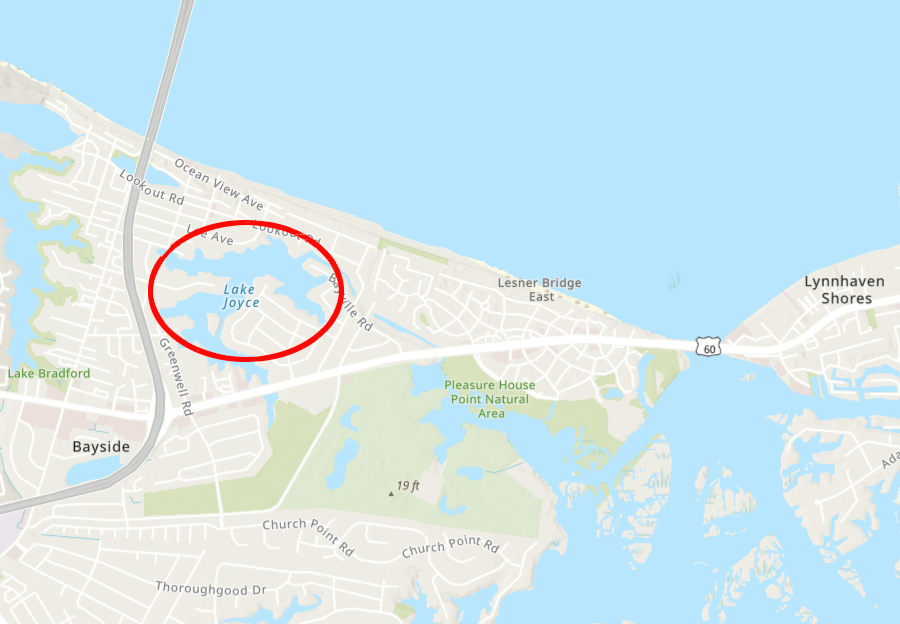
pirate treasure could be buried underneath yards of houses around Lake Joyce, once the outlet of the Lynnhaven River to Chesapeake Bay - or deeper inland, perhaps?
Source: ESRI, ArcGIS Online
Mulberry Island on the northern bank of the James River, now part of Joint Base Langley-Eustis, might have been such an isolated place. A 1954 news story triggered a surge of unsuccessful treasure hunting there. As told in the newspaper, one pirate wrote about a conversation with another pirate while on the island of Madagascar:3
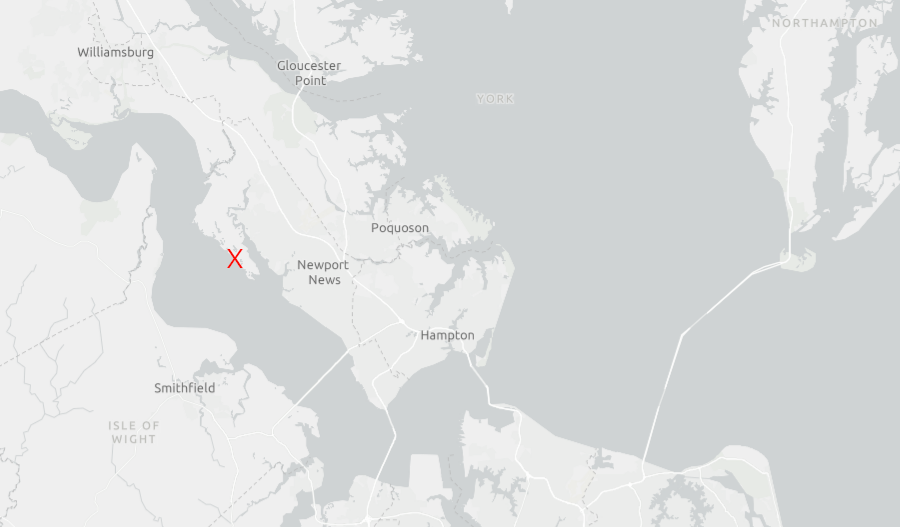
pirates could have sailed up the James River to hide treasure on Mulberry Island (red X)
Source: ESRI, ArcGIS Online
Blackbeard's ship, the Queen Anne's Revenge, has been found in North Carolina. Only two grams (about 790 flakes) of gold dust was found in the sunken ship... so the loot is still lost.4
In Virginia, an association with pirates is a technique to attract tourists. A place must be special, different from "home" in some way, to be worth a visit.
Supposedly Blackbeard's treasure still remains at Virginia Beach - until a tourist stumbles over a chest filled with gold, silver, and jewels, or encounters a "headless specter of the most infamous pirate to ever sail the high seas" seeking to protect his stolen goods.5
There may be pirate treasure buried on Assateague Island near the Virginia-Maryland state line. A British warship intercepted a letter written in 1750 by a pirate in North Carolina saying:6
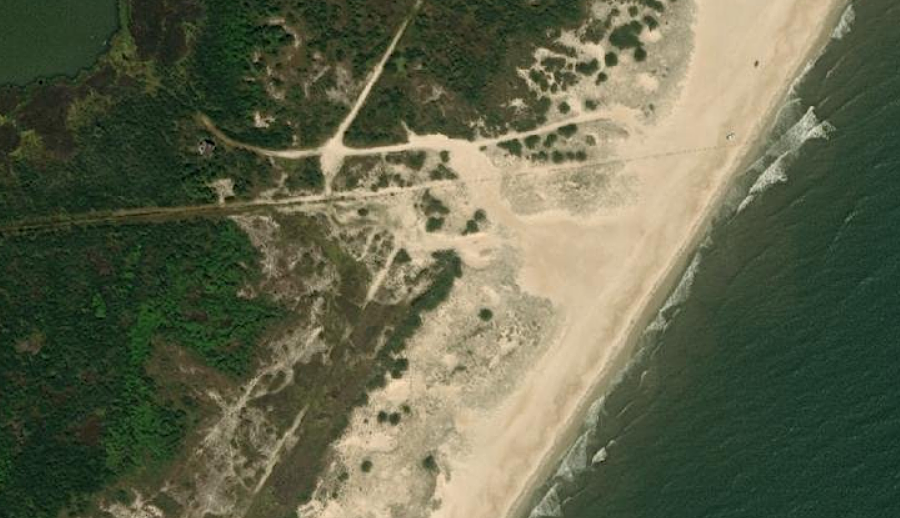
shifting sand on Assateague Island has not revealed buried pirate treasure - yet
Source: ESRI, ArcGIS Online
Stories about mythical treasures get repeated regularly by newspapers, blogs, and websites. Some are based on fragmentary evidence, while others may have been created out of whole cloth.
In 1755 at the beginning of the French and Indian War, General Edward Braddock led an expedition from Alexandria to the site of modern-day Pittsburgh to force the French to abandon an outpost at the headwaters of the Ohio River. According to the legend, Braddock carried gold coins in a wagon to pay for supplies and to compensate the soldiers.
Muddy roads made transportation difficult, so supposedly the gold coins were poured into the barrel of a cannon and buried while on the journey west to the Ohio River. The burial site is claimed to be near Centreville in Fairfax County. Other stories suggest Braddock's gold is buried near Winchester.
Braddock's army was defeated by the French, and the cannon barrel filled with gold coins is still awaiting discovery. Other stories suggest the treasure was buried after the defeat, so it is closer to Cumberland, Maryland.
The story of Braddock's hidden gold treasure is easy to debunk. Braddock and the 48th Regiment crossed the Potomac River into what today is Washington DC. They marched west through Maryland, crossing what is now called Braddock's Heights near Middletown towards Fort Cumberland. The 44th Regiment traveled through Virginia, but those troops marched through what is now Tysons and followed modern Route 7 to cross the Blue Ridge at Vestal's Gap. In 1755 the troops did not go through Centreville, and they did not use the route later called Braddock Road.
There is no historical evidence that Braddock carried a chest full of payroll gold with him, or that troops buried anything more valuable than Braddock's body on the retreat from the defeat. However, the myth is so attractive that the tale continues to be retold.7
![]()
Braddock's gold may be buried in a cannon near Centreville, or in a chest near Winchester - or...
Source: Open Clip Art, Treasure chest from Glitch
The most off-the-chart myth about buried gold in Virginia is associated with the Beale Treasure. According to the tale, between 1819-1821 almost 3,000 pounds of gold and 5,000 pounds of silver, plus jewels. The heavy treasure was carted from Colorado all the way back to Virginia for hiding in the ground.
The tavern keeper at Buford's Tavern in Montvale was entrusted with a box to open after ten years. When he finally did, 23 years later, he found three sheets of paper with codes. The second sheet was decoded to reveal the story. Still unreadable are the first sheet, describing the site of the buried treasure, and the third sheet, revealing who is supposed to receive that treasure.
Believing that story, assuming the Beale party mastered the logistics of transporting gold back across the Mississippi River, may require muting logic circuits in one's brain. The "Is This Local Buried Treasured Mystery Fact – Or Just Fun?" title of a 2020 article reflects the fact that, like Braddock's gold, the tale of the Beale Treasure is too good for writers to resist repeating. In that 2020 article, the local Bedford County resident considered to be the "go to guy" for information regarding the treasure is described as having:8

the third coded letter supposedly reveals who shoud receive the Beale treasure
Source: Wikipedia, Beale ciphers
In April, 1865, the gold, silver, and jewels in the treasury of the Confederate States of America were transported by rail to Danville as Jefferson Davis and other officials escaped before the Union Army marched into Richmond. According to some reports, a portion of that treasure was hidden in Danville rather than transported further south into North Carolina.
Somewhere in Danville, someday, perhaps casks of the Confederate treasure will be found. Archeologists are not supportive of the treasure hunting, because unscientific digging disrupts interpretation of a site.9
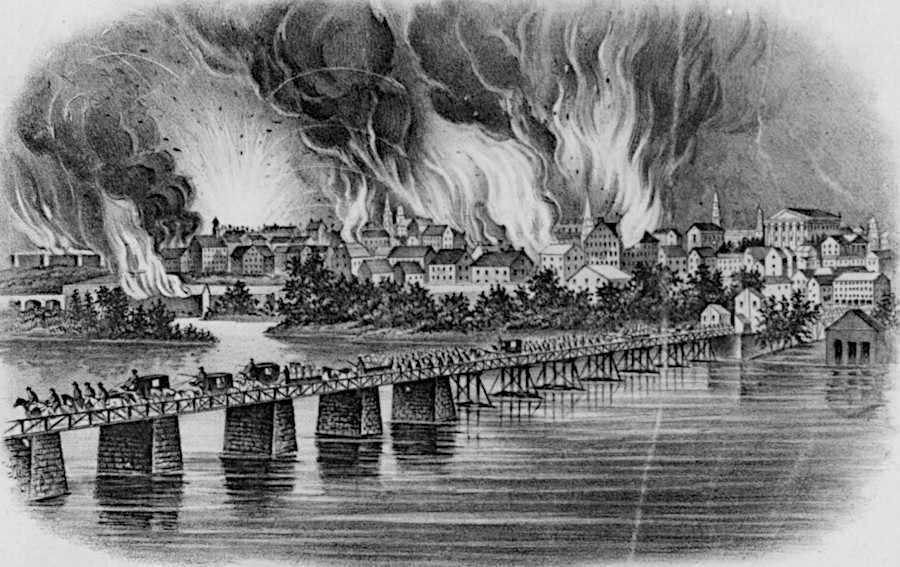
the Confederate treasure was taken south to Danville when Richmond was evacuated on April 3, 1865
Source: Library of Congress, Burning and Evacuation of Richmond, April 3, 1865
Another Civil War treasure is supposedly buried in Northern Virginia. Col. John S. Mosby organized a battalion of Confederate rangers in 1863, used to scout and raid behind Union lines. In March, 1863, Mosby's Rangers captured Fairfax Court House and seized Union General Edwin H. Stoughton, 32 other prisoners and 58 horses. Supposedly the raiders also discovered a sack of gold, silver and jewels which the Union soldiers had stolen from Virginia homes in the area.
Mosby led his men back through the Union lines. Somewhere on the route back to the Confederate forces in Culpeper, perhaps near one of the intersections of modern Routes 29 and 211 in Warrenton, the Rangers encountered a Union patrol. Mosby had the sack of treasure buried between two pines, which he marked with an X. All the Confederates reached Culpeper with their captive men and horses, but when a band returned to unearth the treasure they were captured and hung.
There are incidents of prisoners being hung during the Civil War, but no documentation of the supposed hangings in mid-1863 anywhere in Culpeper, Fauquier, Prince William, or Fairfax counties. Despite the lack of evidence, the tale is repeated that Mosby's treasure worth $350,000 in modern dollars is still buried at a site once marked by two pines with an X carved on each. The pine trees would have died long ago, but the story lives on.10
In Williamsburg, there is a supposed crypt where writings of Sir Francis Bacon are stored. If found, Bacon's wisdom is predicted to lead to a new world order and world peace. The hunt for the vault led to an excavation in 1938 in the graveyard of Bruton Parish Church, two unauthorized excavations in 1991, and another authorized search in 1992. The 1992 search found old graves, but no secret vault with philosophical writings.11
Virginia State Parks has invited people to hunt for buried treasure, but it was advertising for people to search out cultural and natural features that are lesser-visited sites. In this case, the treasures were authentic rather than mythical.
The state park system also encourages geocaching, where the search for a hidden item is the focus. In geocaching, the "treasure" is typically just a chance to record a successful find in a logbook and perhaps exchange trinkets before hiding the container for the next hunter.12
Similarly, the Virginia Department of Conservation and Recreation sponsored a "Virginia Treasures" initiative during the 2013-17 term of Governor Terry McAuliffe. The intent was to create a list of 1,000 of the best natural, cultural and recreational assets in the state. The goal was exceeded, and no subsequent governor re-opened the list for additional sites to be registered.13
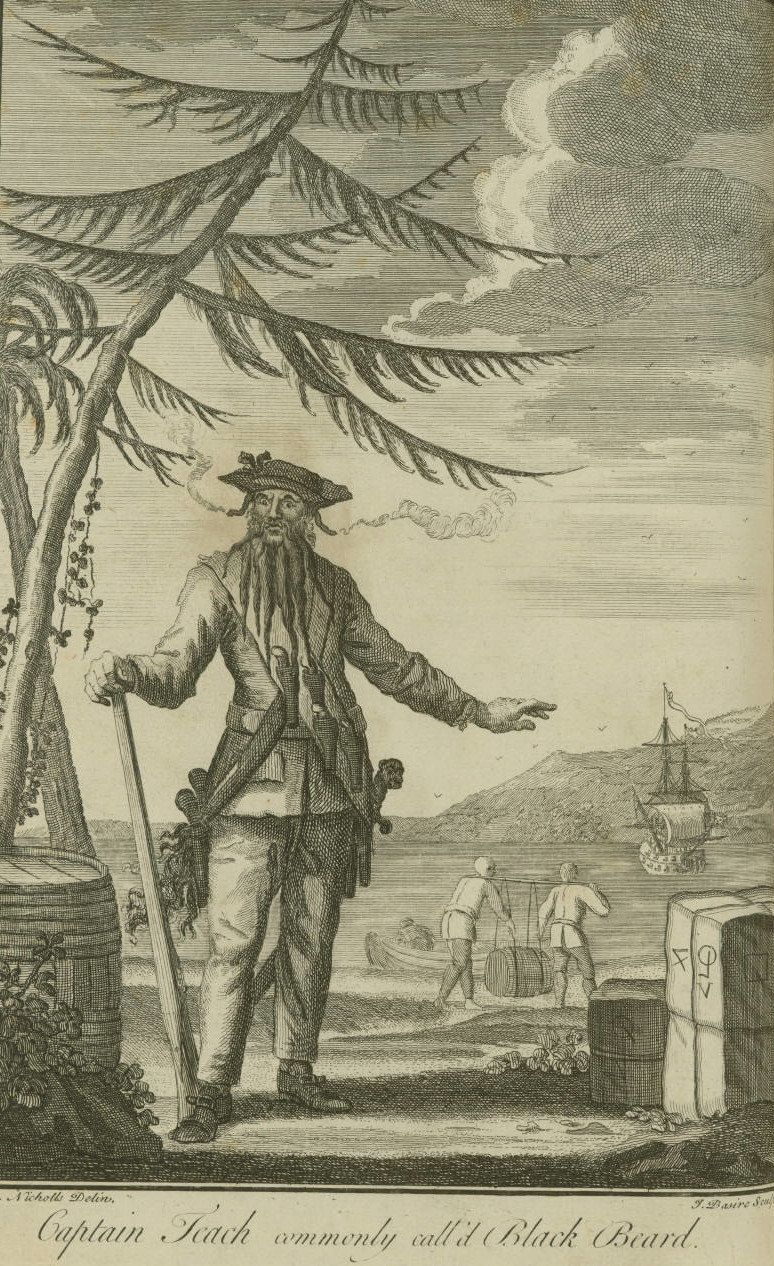
Blackbeard, with the Queen Anne's Revenge in the background
Source: John Carter Brown Museum, Captain Teach commonly call'd Black Beard